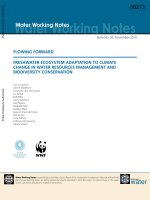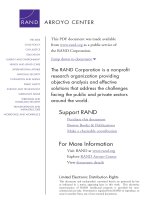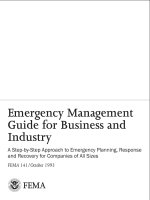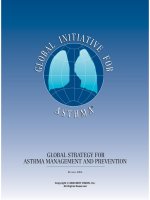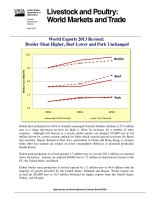Mangrove management and conservation pdf
Bạn đang xem bản rút gọn của tài liệu. Xem và tải ngay bản đầy đủ của tài liệu tại đây (4.53 MB, 350 trang )
United Nations University Press is the publishing arm of United Nations
University. UNU Press publishes scholarly and policy-oriented books
and periodicals on the issues facing the United Nations and its people and
member states, with particular emphasis upon international, regional, and
trans-boundary policies.
United Nations University is an organ of the United Nations estab-
lished by the General Assembly in 1972 to be an international community
of scholars engaged in research, advanced training, and the dissemination
of knowledge related to the pressing global problems of human survi-
val, development, and welfare. Its activities focus mainly on the areas of
peace and governance, environment and sustainable development, and
science and technology in relation t o human welfare. The University op-
erates through a worldwide network of research and postgraduate train-
ing centres, with its planning and coordinating headquarters in Tokyo.
Mangrove management and conservation
This page intentionally left blank
Mangrove management and
conservation: present and future
Edited by M arta Vannucci
a
United Nations
University Press
TOKYO
u
NEW YORK
u
PARIS
6 United Nations University, 2004
The views expressed in this publication are those of the authors and do not
necessarily reflect the views of the United Nations University.
United Nations University Press
United Nations University, 53-70, Jingumae 5-chome,
Shibuya-ku, Tokyo, 150-8925, Japan
Tel: þ81-3-3499-2811 Fax: þ81-3-3406-7345
E-mail: (general enquiries):
United Nations University Office in North America
2 United Nations Plaza, Room DC2-2062, New York, NY 10017, USA
Tel: þ1-212-963-6387 Fax: þ1-212-371-9454
E-mail:
United Nations University Press is the publishing division of the United Nations
University.
Cover design by Joyce C. Weston
Cover photograph by Shigeyuki Baba
Printed in the United States of America
UNUP-1084
ISBN 92-808-1084-7
Library of Congress Cataloging-in-Publication Data
Mangrove management and conservation : present and future / edited by
Marta Vannucci.
p. cm.
Includes bibliographical references and index.
ISBN 9280810847 (pbk.)
1. Mangrove fore sts—Man agement. 2. Mangrove conservation. I. Vannucci, M.
(Marta), 1921–
SD397.M25M373 2004
634.9
0
73763—dc22 2004001198
Contents
List of tables, photographs, and figures . . . ix
Note on measurements xvii
Foreword xix
Introduction and keynote presentation 1
Introduction . . . . 3
Marta Vannucci
Keynote presentation: What we can do for mangroves 8
S. Baba
Part I The mangrove ecosystem: Structure and function 37
1 Some ecological aspects of the morphology of
pneumatophores of Sonneratia alba and Avicennia officinalis 39
T.Nakamura,R.Minagawa,andS.Havanond
2 I ntroduction of Sonneratia species to Guangdong Province,
China 45
Zhongyi Chen, Ruijiang Wang, and Zebin Miao
v
3 Research into, and conservation of, m angrove ecosystems in
Indonesia . . . 51
Aprilani Soegiarto
4 Status of Indian mangroves: Pollution status of the
Pichavaram mangrove area, south-east coast of India 59
AN Subramanian
5 The role of aquatic animals in mangrove ecosystems 76
Shigemitsu Shokita
6 Effects of mangrove restoration and conservation on the
biodiversity and environment in Can Gio District 111
Phan Nguyen Hong
7 Below-ground carbon sequestration of mangrove forests in the
Asia-Pacific region 138
Kiyoshi Fujimoto
Part II Function and management 147
8 Sustainable use and conser vation of mangrove forest
resources with emphasis on policy and management practices
in Thailand 149
Sanit Aksornkoae
9 Role of the national government in the economic
development of the mangroves of Fiji 161
Mesake Senibulu
10 Conflicting interests in the use of mangrove resources in
Pakistan 167
Mohammad Tahir Q ureshi
11 Mangroves, an area of conflict between cattle ranchers and
fishermen 181
Patricia Moreno-Casasola
12 Philippine mangroves: Status, threats, and sustainable
development 192
J.H. Primavera
vi CONTENTS
13 Co-management of coastal fisheries resources in tropical and
subtropical regions 208
Shinichiro Kakuma
14 Mangrove Rehabilitation and Coastal Resource Management
Project of Mabini–Candijay, Bohol, Philippines: Cogtong Bay 219
Robert S. Pomeroy and Brenda M. Katon
Part III Uses and policies 231
15 Towards sustainable use and management for mangrove
conservation in Viet Nam 233
Motohiko Kogo and K iyomi Kogo
16 Mangrove forestry research in Bangladesh 249
A.F.M. Akhtaruzzaman
17 Socio-economic study of the utilization of mangrove forests in
South-East Asia . . . 257
Kazuhiro Ajiki
18 Sustainable mangrove management in Indonesia: Case study
on mangrove planting and aquaculture 270
Atsuo Ida
19 Sustainable use and conservation management of mangroves
in Zanzibar, Tanzania 280
Thabit S. Masoud and Robert G. Wild
Part IV Summary of presentations and guidelines, and action plan 295
20 Summary of presentations and guidelines for future action. . . . . 297
Marta Vannucci and Zafar Adeel
21 Mangroves action plan 302
Zafar Adeel
Acronyms 306
Contributors 308
Index 311
CONTENTS vii
This page intentionally left blank
List of tables, photographs,
and figures
Table 2.1 Mangrove species of Guangdong Province . . . . . . . 46
Table 2.2 Height of Sonneratia apetala after planting 49
Table 4.1 Area under m angroves in India . . . 61
Table 4.2 Physical and chemical parameters observed in the
Pichavaram mangroves during June 1999 and
October 1999 68
Table 5.1 Macrofaunal community at the mangal areas of
South-East Asia and Okinawa . . . . 78
Table 5.2 Macrofaunal habitats and representative animals
on Okinawan and Thai mangals 88
Table 5.3 Comparison of species composition and
abundance of tree fauna between Okinawan and
Thai mangals 90
Table 5.4 Crustacean species found at the mangrove swamp
of the Okukubi River in 1979 and 1997, showing
feeding habits and habitat 92
Table 5.5 Average weekly rates of leaf consumption by
Helice leachi per gram body weight when
provided with green, yellow, and brown leaves of
Bruguiera gymnorrhiza separately 96
Table 5.6 Average weekly rates of leaf consumption by
Helice leachi per gram body weight when
ix
provided with green, yellow, and brown leaves of
Bruguiera gymnorrhiza together 96
Table 5.7 Nutritional composition of green, yellow, and
brown leaves of Bruguiera gymnorrhiza per 100 g
wet weight 97
Table 5.8 Nutritional composition of green, yellow, and
brown leaves of Bruguiera gymnorrhiza per 100 g
dry weight 97
Table 6.1 Can Gio mangroves in 24 forestry units 117
Table 6.2 Rare animals in Can Gio 123
Table 6.3 Physicochemical characteristics of mangrove soils
after reforestation 125
Appendix 6.1 Mangrove flora in Can Gio Mangrove Biosphere
Reserve 127
Appendix 6.2 Zoobenthos in Can Gio Mangrove Biosphere
Reserve 128
Appendix 6.3 Fish in Can Gio Mangrove Biosphere Reserve. . . . . 130
Appendix 6.4 Amphibians and reptiles in Can Gio Mangrove
Biosphere Reserve 132
Appendix 6.5 Birds in Can Gio Mangrove Biosphere Reserve . 133
Appendix 6.6 Mammals in Can Gio Mangrove Biosphere
Reserve 135
Table 7.1 Below-ground carbon storage in mangrove forests
in the Asia-Pacific region 141
Table 7.2 Carbon-burial rates of mangrove forests in the
Asia-Pacific region 142
Table 8.1 Changes in the existing mangrove forest in the
period 1961–1996 152
Table 8.2 Area of mangrove land-use zones by province . . . . . 154
Table 9.1 Principal species of Fijian mangrove vegetation. . . . 163
Table 10.1 Mangrove species of Pakistan, with their
occurrence 169
Table 10.2 Indus River average annual (and seasonal)
discharge volumes downstream of Kotri barrage . . . 169
Table 10.3 Percentage salinity in the Indus delta during
1996 . . 170
Table 10.4 Frequent use of mangroves for fodder. . . 172
Table 10.5 Monthly consumption of mangroves for fuel . . . . . . . 173
Table 10.6 Estimated number of camels in 1996 175
Table 10.7 Rehabili tation of mangroves in the Indus delta
and Balochistan coast 177
Table 11.1 Stakeholders in the area 185
xLISTOFTABLESANDFIGURES
Table 12.1 Major and minor mangrove species in the
Philippines 193
Table 12.2 Economic values placed on products and services
of mangrove systems 195
Table 12.3 Total mangrove and b rackish-water culture-pond
area in the Philippines 197
Table 12.4 Some Philippine regulations on fish-ponds and
mangrove conversion 200
Table 12.5 Some Philippine regulations on mangrove
conservation and rehabilitation 202
Table 13.1 Major fish species caught in Taketomi District. . . . . 217
Table 15.1 Reforestation activities of the ACTMANG
project in 1994–1999 237
Table 15.2 Main activities regarding education 242
Table 16.1 Economically important plants of the Sundarbans
and their uses 252
Table 17.1 Occupational composition in Barangay Lincod,
1992 259
Table 17.2 Household composition and occupations in Tam
Thon Hiep Commune, 1994 262
Table 17.3 Household composition and occupations in Ban
Tha Pradu, 1997 266
Table 18.1 Examples of mangrove planting and traditional
extensive aquaculture 276
Table 19.1 Forest areas of Zanzibar 282
Table 19.2 Forest area and standing volumes for Charawe
and Ukongoroni. . . . . . 291
NB: All photographs can be found at the end of the chapter to
which they refer.
Photo K.1 Small mangrove trees (Kandelia candel )inNaha
City, Okinawa, Japan 16
Photo K.2 Small mangrove trees in Naha City, Okinawa. . . . . . 16
Photo K.3 Mangroves on Iriomote Island, Okinawa 17
Photo K.4 About 200 ha of mangrove forests along the
Nakama River, Iriomote Island, Okinawa . . . . . . . . 17
Photo K.5 Buttress roots of a very old specimen of Herit iera
littoralis, Iriomote Island, Okinawa 18
Photo K.6 Rhizophora sp. with very large stilt roots,
Esmeraldas, Ecuador 18
LIST OF TABLES AND FIGURES xi
Photo K.7 A child in white c lothing stands near the trunk of
a very large tree (Sonneratia sp.), Indonesia . . . . . . . 19
Photo K.8 Destruction of mangrove forests during
construction of a resort hotel 19
Photo K.9 Abandoned shrimp ponds, Bali Island, Indonesia. . 20
Photo K.10 Destruction of mangrove forests during
construction of shrimp ponds, Ecuador 20
Photo K.11 L eaves and young branches of Avicennia sp. are
an important source of cattle fodder in Iran. . . . . . . . 21
Photo K.12 Water buffaloes in Indonesia prefer to eat the
leaves and young twigs of Avicennia marina 21
Photo K.13 Fishes gather under mangrove trees on Iriomote
Island, Okinawa 22
Photo K.14 Birds gather on mangrove trees in Florida, USA . . 22
Photo K.15 Monkeys in mangroves in Viet Nam; m any more
were present, although not visible here. . 23
Photo K.16 Sea lions taking an afternoon nap in the shade of
Avicennia trees on the Galapagos Islands,
Ecuador 23
Photo K.17 Fronds of nipa palms (Nypa fruticans)provide
good materials for thatching in Viet Nam 24
Photo K.18 Thatching with nipa palm leaves, Viet Nam . . . . . . . . 24
Photo K.19 Artistic thatching with fronds of nipa palm, Viet
Nam 25
Photo K.20 Mangrove timber being used as firewood in Fiji . . . 25
Photo K.21 Bark being peeled off wooden billets that will be
burned in kilns to make charcoal, Thailand . . . . . . . . 26
Photo K.22 Charcoal kiln, Thailand 26
Photo K.23 Dyes are extracted from the bark of Bruguiera
and Rhizophora spp. on Iriomote Island,
Okinawa 27
Photo K.24 Dying cloth w ith extracts from the bark of
Bruguiera gymnorrhiza and Rhizophora stylosa,
Iriomote Island, Okinawa 27
Photo K.25 Poles of Bruguiera and Rhizophora spp. are used
in construction work 28
Photo K.26 Abandoned shrimp-ponds on Bali Island,
Indonesia . . . . . . 28
Photo K.27 Potted seedlings of Avicennia sp., Bali 29
Photo K.28 Seeds of Sonneratia alba 29
Photo K.29 Propagules of Rhizophora apiculata, Bali 30
Photo K.30 Propagules of Rhizophora mucronata, Bali 30
Photo K.31 Mangrove nursery, Bali 31
xii LIST O F TABLES A ND FIGURES
Photo K.32 Experimental mangrove plantation in an
abandoned shrimp pond, Bali . . . 31
Photo K.33 Dense mangrove plantation that will require
thinning, Indonesia . . . 32
Photo K.34 Japanese ladies planting mangroves on Lombok
Island, Indonesia . . . . . 32
Photo K.35 Local inhabitants and Japanese volunteers
planting mangroves on Fiji 33
Photo K.36 Mangrove plantation on the occasion of the
Fourth General Assembly of the International
Society for Mangrove Ecosystems (ISME),
September 1999, Bali, Indonesia . . 33
Photo K.37 Mangrove plantation about 20 years old,
Viet Nam 34
Photo K.38 Mangrove plantation about 15 years old,
Viet Nam 34
Photo K.39 Mangrove plantation about 15 years old,
Thailand 35
Photo K.40 Pohnape Island in Micronesia, like other oceanic
islands, faces the danger of a rise in mean sea
level (Photo Nakamura) . . . . 35
Photo 5.1 Crustaceans found in Okinawan mangals (I): (A)
Thalassina anomala;(B)Mictyris brevidactylus;
(C) ecdysis of Scylla serrata;(D)Uca (Amphiuca)
chlorophthalma crassipes;(E)Helice leachi;(F)
mating of Neoepisesarma (N.) lafondi under
laboratory conditions 105
Photo 5.2 Crustaceans found in Okinawan mangals (II): (A)
ovigerous Clibanarius longitarsus; (B) ovigerous
Macrobrachium scabriculum living at the
boundary between brackish and fresh water; (C)
Metapenaeus moyebi;(D)Penaeus monodon 106
Photo 5.3 Molluscs found in Okinawan and T hai mangals:
(A) Geloina coaxans, muddy channel, Iriomote
Island; (B) clusters of Terebralia palustris, rasping
fallen mangrove leaves, Ao Khung Kraben
mangal, Chanthaburi Province of eastern
Thailand; (C) Telescopium telescopium on the
mud-flat of R anong mangal, Thailand; (D)
Rhizophomurex capucinus preying on the young
of Terebralia palustris, Ao Khung Kraben mangal;
(E) Cerithidea quadratai hanging from a dead
mangrove branch, Ao Khung Kraben mangal; (F)
LIST OF TA BLES AND FIGURES xiii
Elobium auris-judae at rest on the trunk of
Rhizophora sp.; (G) a cluster of Cerithidea
rhizophorarum at rest on the trunk of Rhizophora
stylosa, Ishigaki Island mangal, Okinawa 107
Photo 5.4 Tree-dwelling fauna on Ranong mangal,
Thailand: (A) Aegiceras corniculatum at the
seaward edge of transect 2, Ranong, with
sedentary species such as Melina ephippium,
Saccostrea cucullata,andBalanus amphitrite;(B)
a large colony of M. ephippium attached by its
byssus to the trunk of A. corniculatum;(C)
Balanus amphitrite attached to the trunk and
branches of Sonneratia alba;(D)S. cucullata on
the prop roots of Rhizophora mucronata growing
on the creek side of transect 3; (E) Cymia gralata
preying on the S. cucullata encrusting the roots of
A. corniculatum 108
Photo 5.5 Fish species found in Okinawan mangals (I): (A)
Carcharinus leucus (also shown here are Mugil
cephalus, Platycephalus sp., and Acanthopagrus
sp.); (B) Evenchelys macrurus;(C)Mugil
cephalus;(D)Sphyraena barracuda;(E)Apogon
amboinensis;(F)Caranx sexfasciatus 109
Photo 5.6 Fish species found in Okinawan mangals (II): (A)
Gerres filamentosus;(B)Monodactylus argenteus;
(C) Terapon jarbua;(D)Acanthopagrus silvicolus;
(E) Siganus guttatus;(F)Ophiocara poracephala 110
Photo 10.1 Rhizophora mucronata:assistednatural
regeneration in the Indus delta . . . . 180
Photo 10.2 Avicennia marina:plantationintrenchsystemin
Miani Hor 180
Photo 15.1 Kandelia candel reforestation in Tinh Gio: the
seedlings are 6 months old 247
Photo 15.2 Shrimp farming combined with the planting of
Rhizophora apiculata at Ben Tre in the Mekong
delta 247
Photo 15.3 Five lodges have been established in Can Gio, Ho
Chi Minh City, for education and research
regarding mangroves 248
Figure K.1 What we can do for mangroves: Goals 12
Figure K.2 M eans of accomplishing the goals outlined in
figure K.1 12
xiv LIST OF TABLES AND FIGURES
Figure K.3 Roles of the International Society for Mangrove
Ecosystems (ISME) 13
Figure 1.1 Numbers and types of pneumatophores at various
distances from (a) large, (b) m edium-sized, and
(c) small (young) trees of Sonneratia alba 41
Figure 1.2 Proportions of various types of pneumatophores
found on the roots of trees of Sonneratia alba 42
Figure 1.3 Comparison of proportions of pneumatophores of
types A –D on roots of Sonneratia alba from
Ranong and Phang-nga . . . . . 43
Figure 1.4 Correlation between young tree height and cable-
root thickness in Avicennia officinalis and A. alba 43
Figure 2.1 Mean growth height of Sonneratia apetala at
Leizhou, Furongwan, and Jiepao at various times
after planting 49
Figure 4.1 Statewise distribution of mangroves in India 62
Figure 4.2 Pichavaram mangrove forests on the south-east
coast of India 65
Figure 4.3 Spatial distribution of g-HCH in the Pichavaram
mangrove and Vellar estuary during the dry and
wet seasons 71
Figure 4.4 Spatial distribution of DDT in the Pichavaram
mangrove and Vellar estuary during the dry and
wet seasons 71
Figure 4.5 Schematic representation of the flux of g-HCH in
the Vellar watershed 72
Figure 5.1 Sketch of Thailand, showing location of study
sites (and transects T1 –T9) at Smare Kaow and
Ranong . . . . . . . . 80
Figure 5.2 Zonation and abundance of macrofauna at Smare
Kaow 81
Figure 5.3 Zonation and abundance of macrofauna in
transect 1 at Ranong . 83
Figure 5.4 Zonation and abundance of macrofauna in
transect 3 at Ranong . 84
Figure 5.5 Zonation and abundance of macrofauna in
transect 6 at Ranong . 86
Figure 5.6 Four biotopes of the mangrove ecosystem, and
the zonation of dominant groups and species of
the macrofauna in Thailand 87
Figure 5.7 Feeding habits of estuarine fishes 99
Figure 5.8 Food chains in mangroves of Iriomote Island,
Okinawa 101
LIST OF TABLES AND FIGURES xv
Figure 6.1 Map of the Can Gio District, Ho Chi Minh City . . . 112
Figure 6.2 Map of Can Gio mangrove forest and forestry
units 118
Figure 7.1 Relationship between carbon-burial period and
stored carbon for Rhizophora forest in the Asia-
Pacific region 144
Figure 8.1 Sketch of Thailand, showing the main mangrove
areas 159
Figure 12.1 Change in area of mangroves and brackish-water
culture ponds in the Philippines, 1951–1988/1990 . . 198
Figure 12.2 Parallel trends in declining mangrove area and
municipal fisheries production, and increasing
brackish-water pond area and aquaculture
production in the Philippines, 1976 –1998 199
Figure 12.3 Guidelines to mangrove zones as sites for
(extensive) aquaculture ponds . . . 201
Figure 13.1 Catch transition of bottom fish, fish aggregating
device (FAD) fish, and Thysanoteuthis rhombus
(giant squid) 209
Figure 13.2 Catch transition of shellfish and sea urchin. . . . . . . . . 210
Figure 13.3 The fisheries extension process in Samoan
villages 213
Figure 13.4 The fisheries extension process i n Onna Village,
Okinawa 214
Figure 13.5 Marine reserves in Onna Village 215
Figure 13.6 Configurations of Okinawan FADs . . . . 216
Figure 14.1 Location map of Cogtong Bay 221
Figure 15.1 Sketch of Viet Nam showing project areas . . . . . . . . . 238
Figure 16.1 Coastal belt of Bangladesh showing location of
the planted and natural mangrove forests 251
Figure 18.1 Relationships between, and major products of,
each component of the project . . . . 272
Figure 18.2 Flow chart of nursery work: Nursery Manual for
mangrove species at Benoa Port, Bali 273
Figure 18.3 Flow chart of silvicultural activities: Silviculture
Manual for mangroves in Bali and Lombok. . . . . . . . 275
Figure 19.1 Forest types and proportions in Zanzibar . . . . . . . . . . 282
Figure 19.2 Institutional arrangements for community-based
conservation in Zanzibar 289
xvi LIST OF TABLES AND FIGURES
Note on measurements
In this volume:
1 billion ¼ 1,000 million
1ton ¼ 2,240 lb
1 tonne ¼ 1 met ric ton (1,000 kg)
$1 ¼ 1 US dollar
xvii
This page intentionally left blank
Foreword
Man has too long forgotten that the earth was given to him for usufruct alone,
not for consumption, still less for profligate waste.
George Perkins Marsh, Man and Nature,1864
Coastal zones are some of the richest areas in terms of natural resources
and biological diversity. These are the areas that have also seen fierce
human competition for commercial exploitation, urban development, rec-
reational uses, and waste disposal. Underlying this competition i s the fact
that the vast majority of megacities and fastest-growing c ities are located
in (or very close to) coastal zones. The trend for rural populations to
migrate to coastal urban areas has greatly accelerated in recent years;
this is of particular concern in developing countries, where urban areas
often have poor infrastructure, planning, and resources, to begin with.
Another threat to coastal zones has emerged in the last two decades –
global warming and the attendant rise in sea level. Some of the recent
scientific predictions on accelerated sea-level rise as a result of anthro-
pogenically induced global warming are, indeed, alarming.
The focus of this book is on the coastal ecosystems of the tropical and
subtropical regions. These ecosystems – including coral reefs, mangroves,
and estuarine wetlands – are important elements of global primary pro-
ductivity. It is no surprise that about two-thirds of fish caught worldwide
spend some stage of their lives in these ecosystems or a re indirectly de-
pendent on them. It is heartening to observe that considerable research
xix
work has been undertaken to evaluate the status and threats to coral
reefs. Some of the work undertaken by teams from the World Resources
Institute and th eir partners in this respect is highly commendable; how-
ever, the same level of intensity in research work and global attention
is not as obvious for mangrove ecosystems. Any number of reasons may
be cited for this oversight, but ways of improving the situation must
be found, considering the importance of these ecosystems in the overall
picture.
Mangroves must be viewed as an integrated coastal ecosystem com-
prising a rich diversity of flora and fauna. These ecosystems contain pro-
tective habitats – such as spawning grounds, a nursery for juveniles, and
secure feeding grounds – for a wide number of fish, crab, shrimp, and
mollusc species. At the same time, these ecosystems serve as a s anctuary
for indigenous and migratory bird species. Indeed, the richness of bio-
logical diversity in these ecosystems, as described by the broad spectrum
of researchers in this book, is impressive.
Like other coastal ecosystems, mangroves are not safe from human
intervention and destruction. They were traditionally managed by small
coastal communities at a sustainable level, but their intense exploitation
has led to an ever-worsening picture. These ecosystems have become an
easy target for the extraction of wood for fuel and construction, the pro-
duction of food, and waste disposal. The interruption of freshwater flow
into mangroves as a result of dam construction and river-water diversion
has indirectly caused severe – and, in some cases, irreversible – damage.
Land-based sources of pollutants and excess nutrients are yet another
culprit in the long list of negative factors. One damaging factor that
stands above all the rest is unfettered aquaculture and shrimp farming.
The areas suitable for mangroves also have ideal conditions for shrimp
farming. This, coupled with an incredibly high economic return on shrimp
farming, has been the undoing of mangroves: l arge tracts of former
mangrove ecosystems have now been laid waste because of mismanaged
shrimpfarming,whichhasmadethemtoorichinnutrientsandanti-
biotics to sustain a thrivingecosystemofanykind.
There is some ambiguity in defining and understanding the ‘‘original’’
or baseline status of mangrove forests t he world over; nevertheless, sig-
nificant information exists that can be (and has been) used to assess the
overall level of destruction of mangroves. Some of the more dramatic
figures show that about 75 per cent of the mangroves in Myanmar, Ma-
laysia, Pakistan, and the Philippines have been destroyed over the last
few decades; somewhat lower destruction figures are cited for a num-
ber of other countries – for example, about 50 per cent for Angola, Ga-
bon, Indonesia, and Thailand. Regardless of the complete accuracy of
these numbers, it is quite obvious that the scale of destruction is of cata-
xx FOREWORD
strophic proportions. Against this backdrop, it is interesting to note a
lack of focused research and development w ork on mangrove ecosys-
tems. Even more importantly, there appears t o be almost a vacuum in
governmental policies dealing with mangroves: ironically (and tragically),
most governments list mangrove areas as ‘‘wastelands.’’ These deficien-
cies in scientific and policy arenas have prompted international agencies
to react and to take a more proactive stance.
United Nations University (UNU) has always given a high priority to
research and capacity building related to coastal ecosystems. The ratio-
nale for this prioritization is quite obvious when one considers the an-
thropogenic impacts as well as the human reliance on these ecosystems.
A number of initiatives led by UNU have focused on monitoring pollu-
tion, evaluating ecosystem health, and understanding the socio-economic
factors related to the health of coastal ecosystems. These efforts have
typically engaged multidisciplinary teams investigating the interlinked
issues, resulting in networks of researchers and professionals working
towards the ultimate goal of integrated coastal management.
The UNU’s work on coastal-resources management stems from the
early period of the University’s existence. As an example, a project on
‘‘Coastal-Resources Management’’ related to the humid tropical coasts
in Indonesia was initiated in 1979. It was focused on the Cimanuk delta i n
northern Java, which is typical of intensively used deltas in Indonesia.
The project concentrated on training and research courses and on con-
ducting management workshops on selected coastal environments, par-
ticularly in tropical countries. More r ecently, the UNU has been involved
with the Asia-Pacific Mussel Watch, which is an integral part of the In-
ternational Mussel Watch Programme. This programme aims to provide
an assessment of the status and trends of chemical contaminants in the
world’s coastal waters, utilizing mussels and other sentinel bivalves as
indicators of ecosystem health.
Over the past few years, the UNU has been running a project on
environmental monitoring and governance in t he East Asian coastal hy-
drosphere. This project has focused on three elements: (1) building part-
nerships between research groups, international organizations, and in-
dividuals working on c oastal issues; (2) monitoring the coastal waters to
determine pollution levels – particularly those of endocrine-disruptive
compounds; and (3) conducting research and training on ways to con-
serve and protect the region’s precious mangrove ecosystems.
It was a timely intervention when the Government of Japan offered its
financial support to the UNU to tackle some of the challenging issues
relatedtomangroves.TheUNUdeveloped an alliance with UNESCO’s
Man and Biosphere (MAB) Programme and the International Society for
Mangrove Ecosystems (ISME ) to undertake this effort. It was clear that
FOREWORD xxi
a multidisciplinary team of researchers, scientists, and other profession-
als should evaluate the existing situation and describe a framework for
prescriptive remedies; this was realized in the form of an international
workshop in March 2000, jointly organized by the three partners. Very
appropriately, t he islands of Okinawa Prefecture in Japan (where the
only mangrove forests in Japan can be found) were selected for this pur-
pose. The collection of papers presented in this book is extremely en-
lightening in the breadth of the issues covered. The book also raises some
issues that warrant closer inspection and, perhaps, thorough scientific
investigation. These issues run beyond the traditional studies performed
for mangrove ecosystems and offer the opportunity to explore new
frontiers.
First and foremost among these is the carbon-sequestration capacity of
mangroves – both above the surface and below; some preliminary inves-
tigations reported in this book show promising results, on the basis of
which, more in-depth studies on carbon-sequestration processes and ca-
pacity should be undertaken. Findings from such research can have a
significant impact on mangrove-restoration acti vities, particularly if deci-
sion makers in the climate-change ‘‘regime’’ can be fully convinced of
the potential benefits. As an example, from remains of mangroves under
carbon-trading schemes, a new financial source can be tapped. Other
social and economic benefits can be gained through such restoration ac-
tivities, including the provision of employment to communities involved
in restoration activities.
The second most interesting area of scientific research for m angroves
that emerged during some of the discussions in the workshop is related to
recent advances in biotechnology. Mangrove plants show a remarkable
adaptability to a range of water-salinity levels, and current biotechno-
logical techniques have made it possible to i solate the genes responsible
for this salt tolerance. Preliminary research at the Swaminathan Founda-
tion in India has shown that these genes can be successfully transferred to
rice species. If such techniques can be fully developed and replicated on a
large scale, mangroves may, indeed, prove to be the engine for a second
revolution in agricultural production. Needless to say, such technologies
are urgently needed in arid and semi-arid regions, w here brackish water
is often the only option available.
A third area for research is the co mp lete evaluation of the societal
value of mangroves. This should include the reduction in vulnerability
offered by mangroves to coastal communities through protection against
extreme climatic events such as cyclones and floods. The ‘‘bioprospect-
ing’’ value of the mangroves – such as utilization of mangrove species for
medicinal and pharmaceutical purposes – also remains relatively unex-
plored. Through extensive research, these benefits need t o be evaluated
xxii FOREWORD
explicitly and tied in to other existing studies for socio-economic valua-
tion of mangrove ecosystems.
In summary, it is quite obvious that mangroves the world over are
probably at the highest level of threat, as a direct consequence of a num-
ber of human activities in the coastal and adjacen t areas. A new visi on
and appreciation of mangroves is needed to reverse this situation. This
appreciation must extend to all levels of society – from small c oastal
communities, to megacities, to governmental policy makers. International
agencies must also realize their potential role in enlightening people on
mangroves issues, reversing destructive trends, and protecting the exist-
ing precious ecosystems.
Mangrove ecosystems have a great deal to offer us, provided that they
are adequately protected and utilized in a sustainable manner. It is hoped
that this book will help to trigger effective research and policy develop-
ment in that direction.
Zafar Adeel
Tokyo, Japan
March 2001
FOREWORD xxiii



